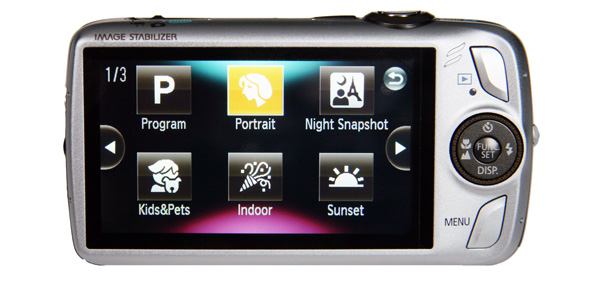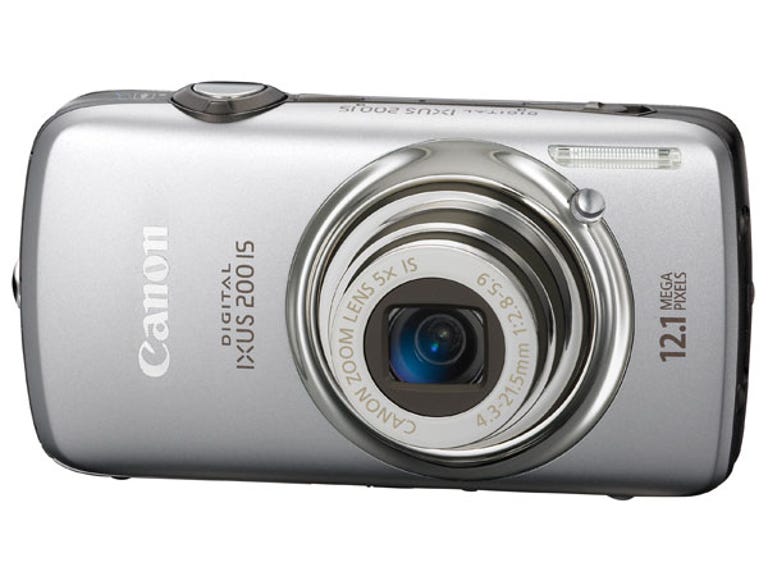 Why You Can Trust CNET
Why You Can Trust CNET Canon IXUS 200 IS review: Canon IXUS 200 IS
Pairing a pretty touchscreen interface with a competent camera is always a good move, but we're a bit stuck as to what the 200 IS actually is: a touchscreen or a conventional compact.
It certainly took Canon long enough to come up with its first touchscreen camera. Other manufacturers like Nikon, Panasonic, Sony and Samsung have had versions that have been around for years, so can Canon bring anything new to the genre?
The Good
The Bad
The Bottom Line
Design
There have been a lot of similarities between the IXUS range in recent months; first we had the IXUS 100 IS and 120 IS which would make even the most astute observer rub their eyes in an attempt to spot the difference. Then came the 110 IS with its elongated styling, an obvious influence on the aesthetic of the 200 IS. Has Canon's designers finally run out of inspiration?
Well from just looking at the outside, we'd dare hazard a guess and say yes they have. At the top of the 200 you will find the same configuration as the 110: a power and shutter button sit side by side, and a mode switch that flicks between movie, program and full automatic completes the top plate.
But here's where things start to get a bit fishy. At the back, alongside the 3-inch widescreen touch LCD, are physical buttons. "Buttons!" we hear you cry? "It's a touchscreen camera!" This perplexes us as much as your imagined retorts.

The pretty, pretty interface. Look, it's purple! (Credit: CBSi)
Fortunately, there are some reassurances thanks to the IXUS tag — it's a solid feeling camera with an ever-so-slightly brushed metal casing. Most controls are nicely positioned and within easy reach, except for one relatively glaring omission — there's no thumb rest. So while you're shooting, anything larger than a diminutive digit will have to perch precariously over the buttons, hoping you won't press anything too hard while you're gripping the camera in your right hand. There's also a helpful warning on a sheet of paper surreptitiously slipped into the box that tells you not to cover the flash with your finger as it discharges (which could happen given its position) otherwise something untoward might happen — like the flash burning out.
Moving back to the 200 IS's screen, it's certainly sturdier than the Sony Cyber-shot T90's screen because Canon has covered it with a protective layer that prevents fingernails or wayward digits from protruding too far into areas uncharted. HDMI output is located on the right side of the camera, but as usual you'll need to invest in a separate cable to make use of this functionality.
Features
Now here's a number we haven't seen for a while on a compact camera's lens — 24mm. That's wide-angle, baby, and we love every minute of it. There's also a reasonable reach on this thing too as it extends to 5x optical zoom. We're very glad to see manufacturers finally fulfilling a lot of what consumers are asking for, but there's still some way to go as something like the Panasonic Lumix DMC-ZR1 has a wide lens (25mm) and an 8x optical zoom reach. The maximum aperture at the wide end is f/2.8 though, great news for low-light photographers. Do note that there are no manual controls on the 200 IS, so if you're aiming for a soft background against a sharp foreground, it's going to be a tough call trying to get the camera to respond accordingly without manual overrides. We'd suggest switching into portrait mode as the camera is more likely to make use of the wide aperture in the aforementioned situation.
Coupled with a 12.1-megapixel sensor and the Digic 4 processor, the 200 IS can also do HD video at 720p and features a myriad of scene modes to choose from. There's the usual gamut of foliage, fireworks and other such settings, but one that took our fancy was creative lighting effect — turning areas of light into shapes of your selection. It aims to recreate a kind of bokeh effect that a lot of SLR photographers achieve by taping a cut-out shape on top of their lens and using a wide open aperture like f/1.4 or f/1.8.
The touchscreen interface has taken a couple of cues from mobile phones like Apple's iPhone, such as the swipe gesture to scroll through photos, and a tap to zoom in on certain sections in playback mode. Tapping the screen during shooting mode allows the user to select a particular focus point, and AF tracking ensures that the selected point is kept in continuous focus even if the subject moves. There is no pinch to zoom in and out though, and some actions are a tad clumsy at first: swiping downwards from the top of the screen will bring up two options on either side of the image when you are in single-view mode, allowing you to either erase the photo by moving your finger to the left, or view the image in a slideshow format by moving it to the right. The downwards motion was a little tricky for our slippery fingers to get accustomed to, and sometimes the camera wouldn't recognise the motion at first. Trial and error is key.
Scroll, scroll, scroll ... get ready to let your fingers do the walking. (Credit: CBSi)
Besides the camera, also included in the box is a wrist strap, battery charger and power cord, mini USB and AV cables, as well as software. There's no printed instruction manual which is a tad disappointing.
Performance
It takes the 200 IS 1.9 seconds to awake from its slumber and take its first shot, which isn't that impressive, and the rest of the performance stakes followed suit: shutter lag was a disappointing 0.15 second, and in continuous mode the camera could only manage to capture one frame every 1.2 seconds.
And with monocle in hand we come to the most perplexing part about this camera — why does it have physical buttons alongside the touchscreen? There's a playback button (understandable), a menu button (somewhat understandable) and a scroll wheel surrounding a round directional pad that acts just like any other Canon IXUS you may have used in the past. It's definitely not a fully immersive touchscreen experience like a lot of the other manufacturers have wheeled out, but it works. The scroll wheel around the directional pad is pleasingly resistive, doing away with that free-wheeling vibe that's been a problem on previous IXUS cameras.
The touch-to-focus and track worked particularly well, following a subject around despite our frantic hand-swaying and moving. If the subject exits the frame though, there's an unceremonious "Touch AF cancelled" that appears on the screen. Also, another aspect to the 200's performance that we found puzzling was the shutter release which appeared intermittently on the screen — a red box with a camera on the right-hand side. While we appreciated having the shutter release at easy reach without needing to move our finger up to the shutter button, we found that the on-screen prompt only appeared when we turned the camera to a portrait or tilted orientation, and even then only appeared after some time. Shutter lag while using the screen release was noticeably increased, too.
Image quality
The 200 delivered some very nice, even exposures without needing to tinker with exposure compensation on automatic and program mode (though, of course, exposure compensation is available as an option by pulling and pushing the meter on-screen). There was a bit of an over-processed feel to images at full magnification, which we only encountered in outdoor or everyday situations — it wasn't visible in studio shots.
Colours appeared nice and natural, without too much of that Canon punch that's characterised many of its cameras of old. The widescreen LCD proved a lot more useful than we expected in terms of framing shots and seeing a whole lot more of the scene, and lens distortions were pleasingly low. Chromatic aberration was very low and the lens coped well with areas of high and low contrast in the one shot.
Comparing the image quality to Panasonic's Lumix FX65, for example, shows that the Canon has slightly more saturated colours, though the Panasonic exhibits an increased dynamic range.
The same image taken with the Canon (top) and the Panasonic FX65 (bottom). (Credit: CBSi)
Then if we compare it to another touchscreen camera like the Sony Cyber-shot T90, we can see that the Canon copes better with controlled lighting and accurate colours — the Sony tends to wash them out just a little bit more.
The Canon (left) and Sony T90 (right). (Credit: CBSi)
Movie quality was good, though we are still puzzled as to why Canon disables the use of the optical zoom while filming. Touch autofocus doesn't work during filming either. The microphone picked up a lot of background as well as foreground noise, though we were pleased with the lack of digital artefacts on the video. The 200 saves movies as .mov files.
Conclusion
We're a little caught between feelings for the 200 IS — on the outside it looks just like any other IXUS, and you can completely get away with never touching (pardon the pun) any of the touchscreen capabilities. Then again, the touch interface is one of the nicest and easiest to use that we've encountered on a compact camera. So this is a bit of a "do it all" camera, that delivers nice images, has some great specs under the hood, but is a little slow to get off the mark. We'd recommend it for the indecisive buyer who isn't quite sure if they want a touchscreen or not, provided you're happy to part with that much cash.


